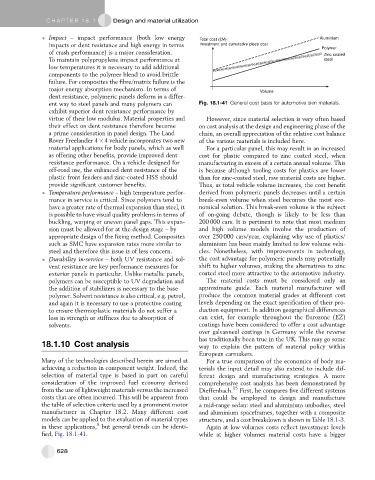Page 617 - Automotive Engineering Powertrain Chassis System and Vehicle Body
P. 617
CHAP TER 1 8. 1 Design and material utilization
Impact – impact performance (both low energy Total cost (£M): Aluminium
impacts or dent resistance and high energy in terms Investment and cumulative piece cost
Polymer
of crash performance) is a major consideration. Zinc coated
To maintain polypropylene impact performance at steel
low temperatures it is necessary to add additional
components to the polymer blend to avoid brittle
failure. For composites the fibre/matrix failure is the
major energy absorption mechanism. In terms of
Volume
dent resistance, polymeric panels deform in a differ-
ent way to steel panels and many polymers can Fig. 18.1-41 General cost basis for automotive skin materials.
exhibit superior dent resistance performance by
virtue of their low modulus. Material properties and However, since material selection is very often based
their effect on dent resistance therefore become on cost analysis at the design and engineering phase of the
a prime consideration in panel design. The Land chain, an overall appreciation of the relative cost balance
Rover Freelander 4 4 vehicle incorporates two new of the various materials is included here.
material applications for body panels, which as well For a particular panel, this may result in an increased
as offering other benefits, provide improved dent cost for plastic compared to zinc coated steel, when
resistance performance. On a vehicle designed for manufacturing in excess of a certain annual volume. This
off-road use, the enhanced dent resistance of the is because although tooling costs for plastics are lower
plastic front fenders and zinc-coated HSS should than for zinc-coated steel, raw material costs are higher.
provide significant customer benefits. Thus, as total vehicle volume increases, the cost benefit
Temperature performance – high temperature perfor- derived from polymeric panels decreases until a certain
mance in service is critical. Since polymers tend to break-even volume when steel becomes the most eco-
have a greater rate of thermal expansion than steel, it nomical solution. This break-even volume is the subject
is possible to have visual quality problems in terms of of on-going debate, though is likely to be less than
buckling, warping or uneven panel gaps. This expan- 200 000 cars. It is pertinent to note that most medium
sion must be allowed for at the design stage – by and high volume models involve the production of
appropriate design of the fixing method. Composites over 250 000 cars/year, explaining why use of plastics/
such as SMC have expansion rates more similar to aluminium has been mainly limited to low volume vehi-
steel and therefore this issue is of less concern. cles. Nonetheless, with improvements in technology,
Durability in-service – both UV resistance and sol- the cost advantage for polymeric panels may potentially
vent resistance are key performance measures for shift to higher volumes, making the alternatives to zinc
exterior panels in particular. Unlike metallic panels, coated steel more attractive to the automotive industry.
polymers can be susceptible to UV degradation and The material costs must be considered only an
the addition of stabilizers is necessary to the base approximate guide. Each material manufacturer will
polymer. Solvent resistance is also critical, e.g. petrol, produce the common material grades at different cost
and again it is necessary to use a protective coating levels depending on the exact specification of their pro-
to ensure thermoplastic materials do not suffer a duction equipment. In addition geographical differences
loss in strength or stiffness due to absorption of can exist, for example throughout the Eurozone (EZ)
solvents. coatings have been considered to offer a cost advantage
over galvanneal coatings in Germany while the reverse
has traditionally been true in the UK. This may go some
18.1.10 Cost analysis way to explain the pattern of material policy within
European carmakers.
Many of the technologies described herein are aimed at For a true comparison of the economics of body ma-
achieving a reduction in component weight. Indeed, the terials the input detail may also extend to include dif-
selection of material type is based in part on careful ferent design and manufacturing strategies. A more
consideration of the improved fuel economy derived comprehensive cost analysis has been demonstrated by
from the use of lightweight materials versus the increased Dieffenbach. 15 First, he compares five different systems
costs that are often incurred. This will be apparent from that could be employed to design and manufacture
the table of selection criteria used by a prominent motor a mid-range sedan: steel and aluminium unibodies, steel
manufacturer in Chapter 18.2. Many different cost and aluminium spaceframes, together with a composite
models can be applied to the evaluation of material types structure, and a cost breakdown is shown in Table 18.1-3.
8
in these applications, but general trends can be identi- Again at low volumes costs reflect investment levels
fied, Fig. 18.1-41. while at higher volumes material costs have a bigger
628

